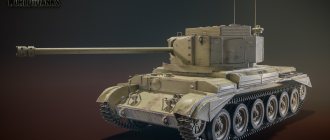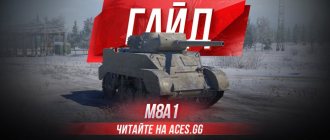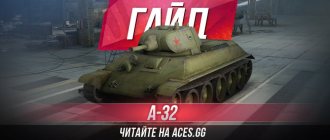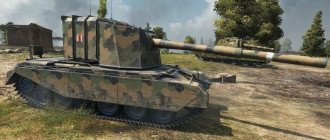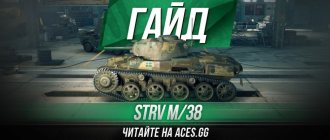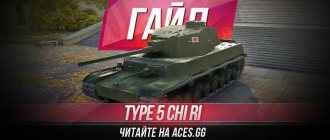Detailed performance characteristics of T95/FV4201 Chieftain
British heavyweight has a strength of 2200 units. This is neither much nor small for this type of equipment, when compared with other Tier X heavy premium tanks. For example, Object 279 early has a result of 2400 units, and Object 260 has a result of 2100 units.
The Chieftain is reinforced with hull armor with an index of 127/88/25 mm, and a turret with 350/175/17 mm. It can be seen that the turret's armor has a greater value, making the special vehicle's gun almost impenetrable.
Continuing the review, let's move on to the characteristics of the weapon. Here it surpasses all its classmates, giving an armor penetration indicator of 270 units (when charged with gold, it can be increased to 310).
A 120 mm Gun_L11 cannon is installed on the heavy weight, the damage indicator is 440 units. It is no different from other Tier 10 premium vehicles.
- Mixing time – 2.1 seconds;
- spread per 100 m – 0.35 m;
- rate of fire - 5.71 rounds per minute;
- damage per minute – 2'514 units.
The machine does not have good stabilization, so accuracy while moving will be lower than at rest. Elevation angles of -7 degrees will give more survivability if used correctly.
Engine power of 1000 horsepower is also included as standard. For example, VK 72/01(K) has a power of 1200 hp, and FV215B - 950 horsepower.
Chieftain’s speed does not disappoint – 46 km/h allows for comfortable movement. The rotation speed is 30 degrees per second, the turret rotation speed is almost the same - 28 degrees per second.
The viewing radius of 410 meters is greater than most of its classmates. The camouflage coefficient is 26%, stealth in motion is 20%. All this will allow you to get close to the enemy, but not expose yourself to artillery attacks.
Design of the Chieftain tank
The layout is classic, the control compartment is in the front of the tank, the combat compartment is in the middle, and the engine and transmission compartment is in the rear. The tank's hull is welded, assembled from cast and rolled parts, while the armor makes up 53% of the tank's mass. The sheets are located at an angle, the profile of the tank is reduced as much as possible.
The driver's workplace is located along the axis of the tank, and it is made in a semi-recumbent form, which made it possible to significantly reduce the height of the front part of the tank. The driver's seat is not attached to the bottom, but to an armor plate installed at a distance of 50 mm from the bottom, which makes it possible to more effectively protect it from mines. Three other crew members are accommodated in the turret. The commander and gunner's positions are located to the right of the gun, the loader's is to the left. When firing, the loader works standing.
The turret of the Chieftain tank has a complex shape - the designers, instead of “squeezing” equipment into its volume, took a different route and designed its profile “around” the equipment and crew seats, which also saved weight and space.
The main armament is a 120-mm L11 rifled gun, installed in the tide of the frontal part of the turret without an armor mantlet (the design of the turret made it possible to create a gun embrasure only 225 mm wide, which makes it possible to do without a mantlet). The gun is equipped with a heat-protective casing and an ejector for purging the barrel bore after a shot.
Drawing of the tank "Chieftain" Mk 3
To improve shooting accuracy and simplify the operation of the gun, its design included a symmetrical arrangement of two recoil brakes, alignment of the trunnion axis with the axis of the barrel bore, a quick-release connection between the barrel pipe and the breech, and built-in pressure control. The 120 mm L11 cannon has separate loading. Powder charges are contained in silk bags that burn completely when fired, and the containers of powder charges are made of fire-resistant material. When fired, the charge is ignited using ignition tubes supplied automatically from under the breech of the gun. The magazine capacity in the feed mechanism is ten tubes. The gun is loaded manually using a hydromechanical rammer.
The cannon and coaxial machine guns are stabilized in two planes. The stabilization system was developed on the basis of a similar system of the Centurion tank. Despite the stabilization of the gun, the main firing mode is shooting from a place. The fire control system allows the gunner to aim the gun at the target before approaching the opening fire line; stopping is only necessary to fire a shot from the gun.
The distance to the target at distances up to 2000 m is determined using a sighting 12.7 mm machine gun. When firing high-explosive shells from closed positions, data preparation is necessary, as when firing from conventional towed guns.
Using the optical channel, the commander can mark the selected target in the field of view of the gunner's sight. Aiming the gun is possible both by the gunner and the commander, and the actions of the latter are considered priority. Shooting at night is carried out using AVL1A1 IR sights, which are installed instead of the commander's and gunner's day sights. To illuminate targets, a xenon searchlight No. 2 Mk 3 is installed on the left side of the turret.
The commander's cupola, for better retention of the target in sight and ease of observation when turning the turret, rotates in the direction opposite to the direction of rotation, keeping the line of sight unchanged; full turn time - 16 s. The turret contains nine fixed periscope observation devices AFV No. 49 with a total field of view of 360°. The commander's hatch is double-leaf. The loader's view is provided through a periscope observation device of circular rotation AFV No. 30Mk 1. Two six-barreled 66-mm smoke grenade launchers are mounted on the sides in the front of the turret. Two radio stations are installed in the aft niche of the tower: VHF and shortwave. The tank is equipped with a protection system against weapons of mass destruction and a fire extinguishing system.
The Chieftain's undercarriage is almost identical to the undercarriage of the Centurion tank and includes six road wheels on board, with rear-mounted drive wheels. The chassis is covered with four-section steel screens 10-15 mm thick for protection against light cumulative anti-tank weapons.
Equipment and perks
In order to determine the required pumping area, it is worth taking a look at the technical specifications again. We offer a similar assembly based on these characteristics; each tanker, in any case, adjusts his equipment to his individual playing style.
· Vertical guidance stabilizer – will correct the problematic stabilization of the armored car;
· Rammer to increase reload speed;
· Ventilation will increase crew skill.
Speaking about the crew, I would like to say about the skill of repairing equipment and fire fighting. A fairly standard set, but very useful in battle.
In popular culture
Bench modeling
The Chieftain tank is represented to a limited extent in bench modeling. Prefabricated plastic replica models of the Chieftain tank on a scale of 1:35 are produced by Tamiya (Japan). The model is distinguished by average elaboration and detail. 05/23/2015 - Takom demonstrated a 3D model of the base of this tank.
Takom has released four modifications of the Chieftain tank in 1:35 scale Mk 2.
(catalog number 2040),
Mk 5/P
(catalog number 2027),
Mk10
(catalog number 2028),
Mk11
(catalog number 2026).
Rock music
Tank Chieftain is featured on the cover of Uriah Heep's 1971 album Salisbury.
Electonic music
Tank Chieftain is featured on the cover of The Chemical Brothers' 2022 album No Geography.
In computer games
In most new games, the Chieftain tank will be presented as an MBT (main battle tank) or a ST (medium tank).
The tank is presented in modifications Mk2, Mk6, Mk10 and Mk11 in the MMO Armored Warfare. It is possible to install additional armor protection “Stillbrew”.
Present in the browser shooter Red Crucible Firestorm. There are also mods for the game “Behind Enemy Lines 2: Assault” that add the Chieftain tank to this game.
Introduced in the massively multiplayer online game War Thunder, in patch 1.57: “Spring March”. The tank is available in modifications Mk.3, Mk.5, Mk.10 (with attached steelbrew armor) and occupies the sixth rank in the development branch of the British armored forces.
Introduced in the MMO World Of Tanks by the Cheiftain/T95 variant - the tank was issued for a campaign on the Global Map called “Asian Typhoon” for fame points (about 15 thousand). In the game it is a British Tier VIII medium tank. A heavy one also appeared at level X, called T95/FV4201 Chieftain.
Crew skills and abilities
The Chieftain is not historical, but the design of this machine existed. It was because of the impossibility of selecting a crew that the project was closed.
So, the vehicle has a crew of four people: a commander, a gunner, a driver and a loader (radio operator).
We propose to train the crew in the following way:
- Commander – “The Sixth Sense”, “Repair”, “Combat Brotherhood”, “Disguise”;
- Gunner – “Repair”, “Smooth rotation of the tower”, “Combat brotherhood”, “Disguise”;
- Driver - “Repair”, “Smooth ride”, “Combat brotherhood”, “Disguise”;
- Loader (radio operator) – “Repair”, “Radio interception”, “Combat brotherhood”, “Disguise”.
Modifications of the British tank "Chieftain"
Mk 1 (1965) - pre-production version with 585 hp engine. 40 units produced.
Mk 2 (1966) - the first production modification with a cast turret, a 120-mm L11A2 rifled gun with separately loaded ammunition and a barrel length of 55 calibers. Engine L60 Mk 4 650 hp Combat weight 51.6 tons. Crew 4 people. 532 units produced.
Mk 3 (1969) - L60 engine No. 4 Mk 6 rated at 720 hp, commander's cupola No. 15 Mk 2 with a single hatch, equipped with improved optics and an L37A1 anti-aircraft machine gun. Machine gun pointing angles in the vertical plane from -10° to +75°. The machine gun's aiming in the vertical plane is synchronized with the optical axis of the commander's binocular sight. To fire a machine gun at air targets, an anti-aircraft sight is installed. Combat weight 54.1 tons. 199 units manufactured.
Mk 3/3 (1970) - Chieftain with Barr & Stroud No. 1 Mk 2 laser rangefinder integrated into the gunner's main sight; engine L60 No. 4 Mk 6A with a power of 730 hp, 120 mm L11A3 cannon; improved exhaust fan in the fighting compartment. 29 units produced.
Mk Z/ZR (1970) - export version of the Mk 3 for Iran.
Mk 4 (1970) - experimental version with increased fuel capacity and reduced ammunition for the sighting machine gun. 2 units produced.
Mk 5 (1971) - Mk 3/3 with L60 engine No. 4 Mk 7A, modernized L11A5 cannon with a collimator for aligning the gunner's sight, modernized sighting machine gun, 1FCS control system, commander's cupola No. 21 with XL 161 heat direction finder. Improved ESD system. The survivability of the gun barrel has been increased. 97 units produced.
The structure of the main tank "Challenger" (reworking of the "Chieftain" project), pay attention to the position of the driver
Mk 5/5Р (1971) - export version of the Mk 5 for Iran. Engine L60 No. 4 Mk 8A with a power of 750 hp. 785 units produced.
"Chieftain" Mk 5/5K (1971) - export version of the Mk 5 for Kuwait. 165 units produced.
Chieftain Mk 6 (1976) - Mk 2, upgraded to Mk 5.
Chieftain Mk 7 (1976) - Mk 3 upgraded to Mk 6.
Chieftain Mk 8 (1976) - Mk 3/3 upgraded to Mk 6.
Chieftain Mk 9 (1981) - Mk 6 equipped with FFCS fire control system.
Chieftain Mk 10 (1981) - Mk 7 equipped with 1FCS fire control system.
Mk 11 (1981) - Mk 8 equipped with an IFCS fire control system, a thermal imaging gunner's sight, a new ESD system and Stillbrew passive armor protection units mounted on the front of the turret and hull.
Mk 15 - export modification for Oman. 15 units produced.
FV 4030/1 is an improved export version for Iran with an upgraded suspension, increased fuel tank capacity and enhanced armor protection. 187 units produced.
Also based on the Chieftain tank, a family of auxiliary vehicles was created:
Bridgelayer (sapper tank) Chieftain AVLB. A bulldozer blade or mine trawl was mounted in front of the tank hull. The crew of the car is three people. From 1989 to 1994, he converted 48 base tanks of various modifications into this vehicle.
The Chieftain ARV ARV was produced by Vickers since 1974 and was based on the chassis of the Chieftain Mk 5 tank. Two hydraulic winches driven by the main diesel engine are installed in the front of the hull. The traction force of the main winch is 30 tons, the auxiliary one is 3.5 tons. The cable length of the main winch is 122 m, the auxiliary one is 260 m. A bulldozer blade is mounted in the front part of the hull, and on the right side of the hull there is an ATLAS AK 6000M crane with a lifting capacity of 5.8 t. Crew 4 people, ARV weight - 56 tons. Armament consists of a 7.62 mm remote-controlled machine gun and a 66 mm smoke grenade launcher. 41 vehicles were purchased by Iran, and another 30 ARVs were purchased by Jordan.
BREM ARRV - the same BREM ARV, but equipped with a hydraulic crane of greater lifting capacity, for field repair of the tank (engine replacement). Converted from part of an ARV ARV.
In addition, the Chieftain tank served as the basis for the Iranian Shir 1 tank.
British Chieftain main tank
Combat tactics
Each tanker has his own combat tactics, but we can suggest, based on the characteristics, what is suitable for this special vehicle.
When choosing a firing line, you should still choose the second one. This way you won’t expose insufficiently good armor to attack and will be able to realize your main advantage - weapons.
It would be best to take cover behind bushes or use the terrain of the ground to your advantage without exposing your body to fire.
It's better to be social and work as a team than to fight alone. You should never forget about the vulnerability of this technique and do not try to attack broadside.
Good luck in battle, tankman!
Combat use
Like its other European competitors, the Chieftain was widely exported to other countries, mainly to the Middle East. Unlike its predecessor, the Centurion tank, the Chieftain was not adopted by other NATO and Commonwealth countries.
The Chieftain has proven itself to be a well-built tank. Another important advantage was that the tank had sufficient technical groundwork, allowing it not only to constantly modernize it by installing new technical components, but also to adapt the vehicle to the requirements of local theater operations. The Chieftain tank was constantly modernized until the early 1990s, when it was replaced by the Challenger tank, the design of which was largely influenced by the Chieftain. The latest modifications of the Chieftain Mk.9 and Mk.10, which were in service with the British Army until 1995, featured new additional “stillbrew” armor .
. Stillbrew), an improved fire control system and a thermal imaging surveillance system for the gunner.
Stillbrew overlay armor (metal-polymer blocks) was developed by Colonel Still and John Brewer, both MVEE employees. The decision was made as a result of the Iran-Iraq war, when the Iranian "Chieftains" showed vulnerability to the 125-mm finned sub-caliber projectiles of the T-72 tanks, as well as to the cumulative warheads of ATGMs.
Chieftain tanks were supplied to at least six countries, including Iran, Kuwait, Oman and Jordan.
Iran-Iraq War
The largest batch of vehicles was sold to Iran: before the 1979 revolution, 894 modifications were received there: Mk 3 and Mk 5(P) and 55 Chieftain ARVE. As a result, the Iranian army had more of these tanks than Great Britain itself. Events in 1979 stopped further supplies. Before the war, in 1980, Great Britain supplied Iraq with 29 Chieftain AVRE (an abbreviation for Armored Vehicle Royal Engineers). The main military conflict in which the Chieftains were used was the Iran-Iraq War, which lasted from 1980 to 1988.
"Chieftains" were the most popular tanks in Iran. By the beginning of the war, there were 894 tanks and 55 ARVs of this type. They were with the 81st Armored Division (1st, 2nd and 3rd Brigades) in Kermanshah, the 92nd Armored Division (1st, 2nd and 3rd Brigades) in Khuzestan and the 88th th tank brigade (one battalion in Khuzestan, the rest on the border of Afghanistan and the USSR). Each brigade was armed with 125 Chieftain tanks. The 81st and 92nd divisions also had a regiment of about 80 Scorpio light tanks. At the beginning of the war, Iraq had 29 ARVs based on the Chieftains.
At the beginning of the war, Iranian tanks suffered heavy losses and many tanks were captured. On November 10, the Iraqis held an exhibition of captured weapons in Baghdad, at which there were 58 Chieftains. They were adopted by the 6th Armored Division of Iraq. At the end of 1980, Iraq had 31 Chieftain tanks in service. On January 5-9, 1981, Iranian tanks took part in the largest tank battle of the war near Dizful. 300 Iranian Chieftains and Pattons fought with 300 Iraqi T-62s. The Iranian attack was repulsed. According to Iraq, the Iranians lost 214 tanks in the three-day battles. Iran admitted the loss of only 88 vehicles, but foreign journalists counted a much larger number of damaged and abandoned Iranian tanks. So, according to their data, only 150 tanks were left on the battlefield; how many more damaged Iranians managed to evacuate remains unknown. Iraq, according to journalists' calculations, lost approximately 40 T-62 tanks. During these battles, the Iranians became convinced that the 115-mm finned sub-caliber projectiles of the U-5TS cannon penetrated the frontal armor of the Chieftains. The Iranian "Chieftains" performed well in the battle for Abadan. During the July battles near Basra, the first encounters with T-72 tanks were noted. About 50 Chieftains were captured during these battles.
In 1982, Iraq formed an entire tank division (17th) from captured Chieftains and other Iranian tanks. The Iraqis purchased spare parts for the repair of the Chieftains from Great Britain in 1985; before that, they dismantled their ARVs to repair captured tanks. There is unconfirmed information that in 1984 Iraq bought 50 Chieftain Mk.5 tanks from Kuwait. Iran was also looking for opportunities to supply spare parts for tanks. The Americans stated that Iran received spare parts for the Chieftains from Israel.
During the fighting, it turned out that the Chieftain's 120-mm gun was guaranteed [ how?
] amazes[
with what?
] all Soviet-made tanks in service with Iraq, including the most modern T-72. The combat clashes between the T-72 and the Chieftain were accompanied by heavy losses on both sides. The Chieftains fought their last major tank battle during Operation Forty Stars.
By the end of the war, Iran had just over 60 Chieftains left. It is noteworthy that by the end of the war, Iraq had more of these tanks than Iran - in total, up to 300 vehicles were captured during the war. In 1989, Iraq, having difficulties with the repair and maintenance of British-made tanks, sold Jordan 120 Chieftains captured in the war, including 30 vehicles in fully operational condition.
Kuwait-Iraq War
"Chieftains" were used during the Kuwait-Iraq war in 1990. Kuwait had 165 tanks of this type. Thus, during the “Battle of the Bridges” in the southern suburbs of Kuwait City, units of the Iraqi tank division, equipped with T-72 tanks and infantry fighting vehicles, entered Kuwait City and encountered the 35th Kuwait Tank Brigade, which was armed with 35 Chieftain tanks. “, - one of the few units of the Kuwaiti army that offered organized resistance. The Iraqi advance in this area was briefly stopped. The Kuwaitis stated that they shot down and destroyed 25 Iraqi T-72s and 15 T-55/T-62s. Only 18 tanks of the 35th brigade were able to leave for Saudi Arabia. 136 shot down and abandoned Kuwaiti Chieftains were captured by Iraq.
Operation Desert Storm
Before Operation Desert Storm, the number of Chieftain tanks in the exiled Kuwaiti Army in Saudi Arabia was increased to 80 vehicles due to urgent deliveries from the UK; they entered Iraq as part of the Multinational Force. Before the operation, Iraq had much more of these tanks: 200-300 vehicles of various modifications, in addition there were several Chieftain AVRE, facts of their limited use were noted. During the fighting, Iraq lost several tanks and one armored vehicle.

